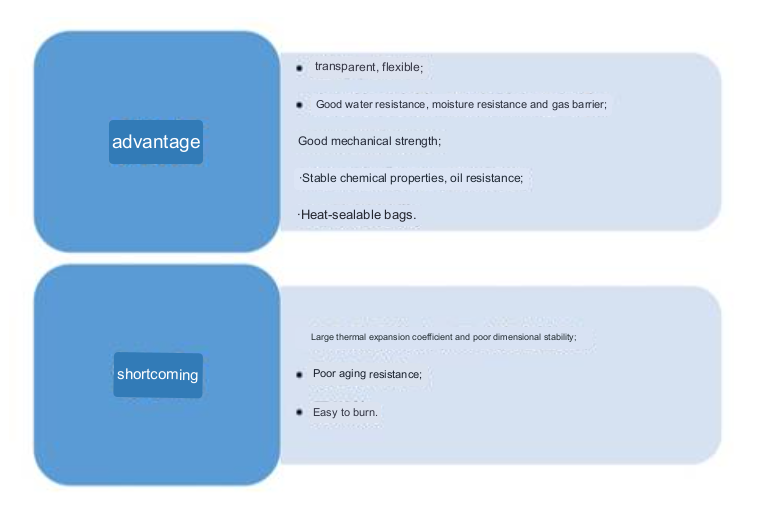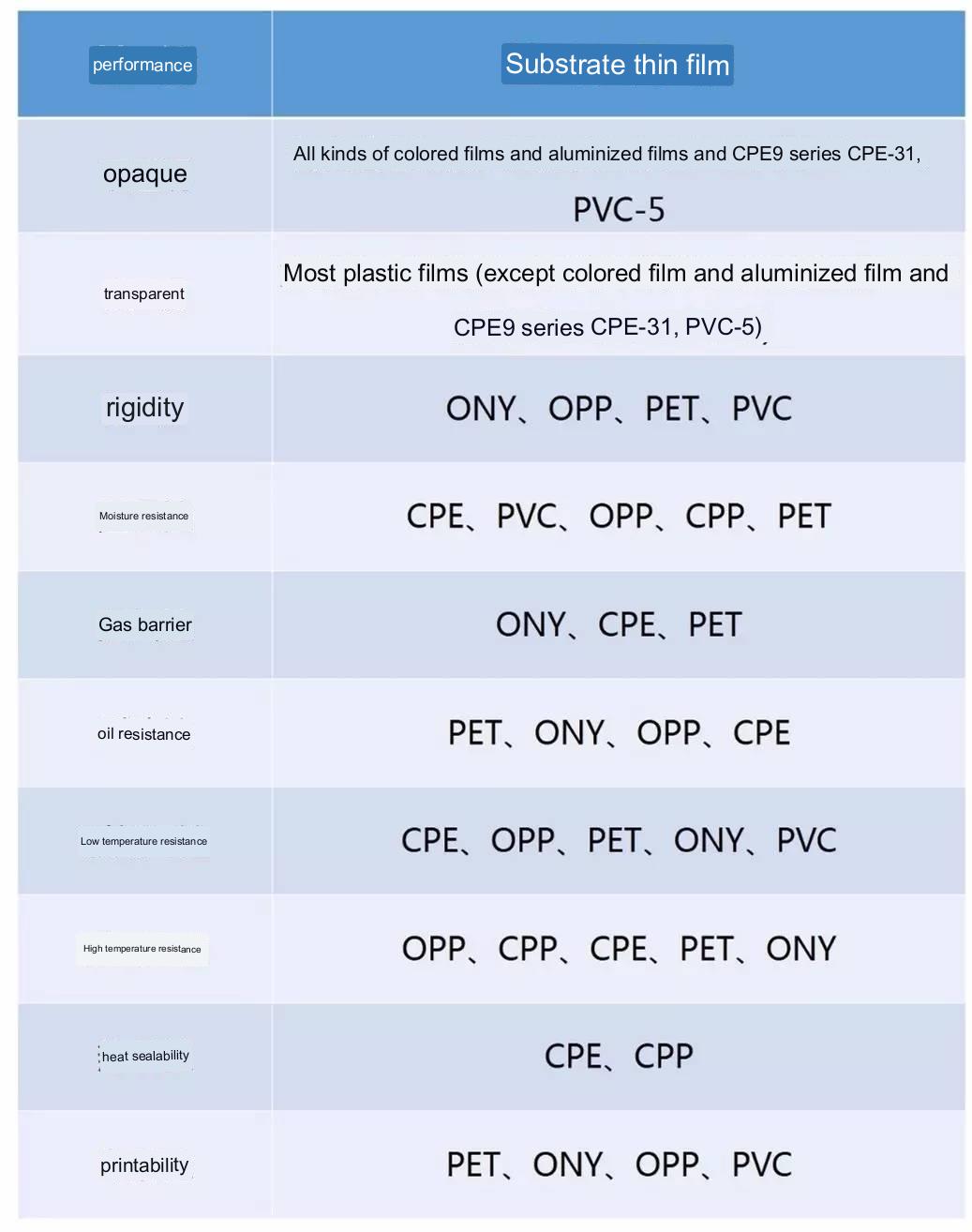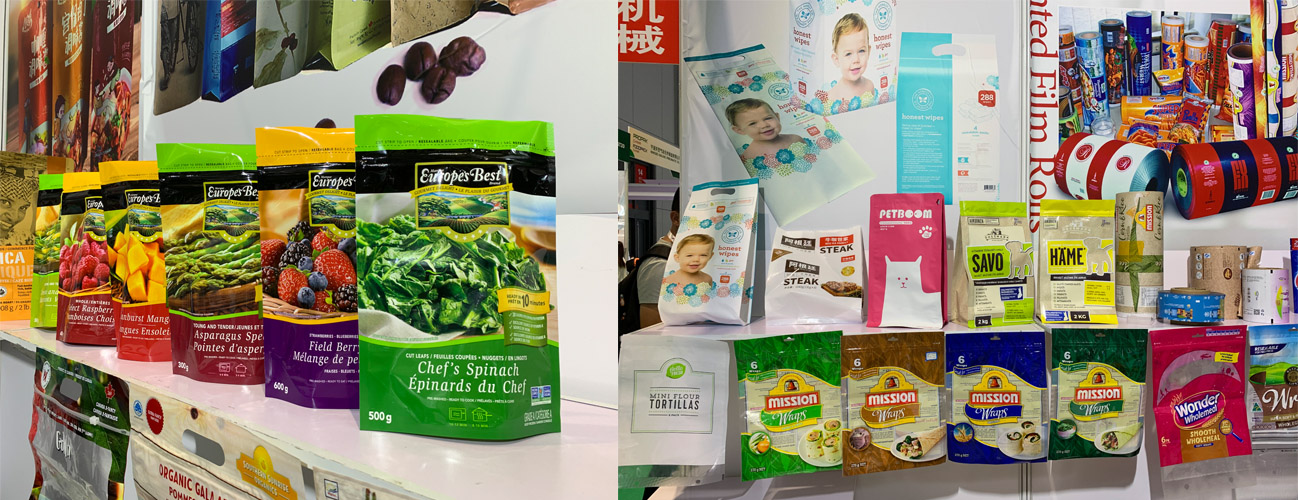Various films are often used in daily life. What materials are these films made of? What are the performance characteristics of each? The following is a detailed introduction to the plastic films commonly used in daily life:
Plastic film is a film made of polyvinyl chloride, polyethylene, polypropylene, polystyrene and other resins, often used in packaging, construction, and as a coating layer, etc.
Plastic film can be divided into
–Industrial film: blown film, calendered film, stretched film, cast film, etc.;
– Agricultural shed film, mulch film, etc.;
–Films for packaging (including composite films for pharmaceutical packaging, composite films for food packaging, etc.).
Advantages and disadvantages of plastic film:
Performance characteristics of main plastic films:
Biaxially Oriented Polypropylene Film (BOPP)
Polypropylene is a thermoplastic resin produced by the polymerization of propylene. Copolymer PP materials have a lower heat distortion temperature (100°C), low transparency, low gloss, and low rigidity, but have stronger impact strength, and the impact strength of PP increases with the increase of ethylene content . The Vicat softening temperature of PP is 150°C. Due to the high degree of crystallinity, this material has very good surface stiffness and scratch resistance properties. PP does not have environmental stress cracking problems.
Biaxially oriented polypropylene film (BOPP) is a transparent flexible packaging material developed in the 1960s. It uses a special production line to mix polypropylene raw materials and functional additives, melt and knead them into sheets, and then stretch them into films. It is widely used in the packaging of food, candy, cigarettes, tea, juice, milk, textiles, etc., and has the reputation of “Packaging Queen”. In addition, it can also be applied to the preparation of high value-added functional products such as electrical membranes and microporous membranes, so the development prospects of BOPP films are very broad.
BOPP film not only has the advantages of low density, good corrosion resistance and good heat resistance of PP resin, but also has good optical properties, high mechanical strength and rich sources of raw materials. BOPP film can be combined with other materials with special properties to further improve or improve performance. Commonly used materials include PE film, salivating polypropylene (CPP) film, polyvinylidene chloride (PVDC), aluminum film, etc.
Low Density Polyethylene Film (LDPE)
Polyethylene film, namely PE, has the characteristics of moisture resistance and low moisture permeability.
Low-density polyethylene (LPDE) is a synthetic resin obtained by ethylene radical polymerization under high pressure, so it is also called “high-pressure polyethylene”. LPDE is a branched molecule with branches of different lengths on the main chain, with about 15 to 30 ethyl, butyl or longer branches per 1000 carbon atoms in the main chain. Because the molecular chain contains more long and short branched chains, the product has low density, softness, low temperature resistance, good impact resistance, good chemical stability, and generally acid resistance (except strong oxidizing acids) , Alkali, salt corrosion, has good electrical insulation properties. Translucent and glossy, it has excellent chemical stability, heat sealability, water resistance and moisture resistance, freezing resistance, and can be boiled. Its main disadvantage is its poor barrier to oxygen.
It is often used as the inner layer film of composite flexible packaging materials, and it is also the most widely used and used plastic packaging film at present, accounting for more than 40% of the consumption of plastic packaging films. There are many kinds of polyethylene packaging films, and their performances are also different. The performance of single-layer film is single, and the performance of composite film is complementary. It is the main material of food packaging. Secondly, polyethylene film is also used in the field of civil engineering, such as geomembrane. It acts as a waterproof in civil engineering and has very low permeability. Agricultural film is used in agriculture, which can be divided into shed film, mulch film, bitter cover film, green storage film and so on.
Polyester film (PET)
Polyester film (PET), commonly known as polyethylene terephthalate, is a thermoplastic engineering plastic. It is a film material made of thick sheets by extrusion and then biaxially stretched. Polyester film is characterized by excellent mechanical properties, high rigidity, hardness and toughness, puncture resistance, friction resistance, high temperature and low temperature resistance, chemical resistance, oil resistance, air tightness and fragrance retention. One of the permanent composite film substrates, but the corona resistance is not good.
The price of polyester film is relatively high, and its thickness is generally 0.12 mm. It is often used as the outer material of food packaging for packaging, and has good printability. In addition, polyester film is often used as printing and packaging consumables such as environmental protection film, PET film, and milky white film, and is widely used in industries such as glass fiber reinforced plastics, building materials, printing, and medicine and health.
Nylon plastic film (ONY)
The chemical name of nylon is polyamide (PA). At present, there are many varieties of nylon industrially produced, and the main varieties used to produce films are nylon 6, nylon 12, nylon 66, etc. Nylon film is a very tough film with good transparency, good gloss, high tensile strength and tensile strength, and good heat resistance, cold resistance, oil resistance and organic solvent resistance. Excellent wear resistance and puncture resistance, relatively soft, excellent oxygen barrier properties, but poor barrier properties to water vapor, high moisture absorption and moisture permeability, poor heat salability, suitable for packaging hard items, such as greasy Sexual food, meat products, fried food, vacuum-packed food, steamed food, etc.
Cast Polypropylene Film (CPP)
Unlike the biaxially oriented polypropylene film (BOPP) process, the cast polypropylene film (CPP) is a non-stretched, non-oriented flat extrusion film produced by melt casting and quenching. It is characterized by fast production speed, high output, good film transparency, gloss, thickness uniformity, and excellent balance of various properties. Because it is flat extruded film, follow-up work such as printing and compounding is extremely convenient. CPP is widely used in the packaging of textiles, flowers, food, and daily necessities.
Aluminum-coated plastic film
The aluminized film has both the characteristics of a plastic film and the characteristics of a metal. The role of aluminum plating on the surface of the film is to shield light and prevent ultraviolet radiation, which not only prolongs the shelf life of the contents, but also improves the brightness of the film. Therefore, aluminized film is widely used in composite packaging, mainly used in dry and puffed food packaging such as biscuits, as well as the outer packaging of some medicines and cosmetics.
Post time: Jul-19-2023






